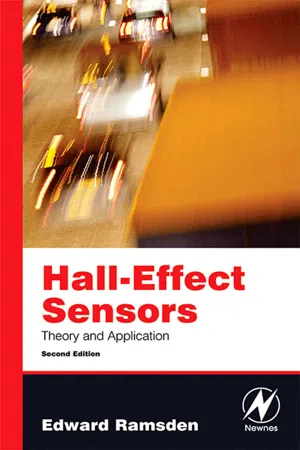
- 272 pages
- English
- ePUB (mobile friendly)
- Available on iOS & Android
About This Book
Without sensors most electronic applications would not exist—sensors perform a vital function, namely providing an interface to the real world. Hall effect sensors, based on a magnetic phenomena, are one of the most commonly used sensing technologies today. In the 1970s it became possible to build Hall effect sensors on integrated circuits with onboard signal processing circuitry, vastly reducing the cost and enabling widespread practical use. One of the first major applications was in computer keyboards, replacing mechanical contacts. Hundreds of millions of these devices are now manufactured each year for use in a great variety of applications, including automobiles, computers, industrial control systems, cell phones, and many others. The importance of these sensors, however, contrasts with the limited information available. Many recent advances in miniaturization, smart sensor configurations, and networkable sensor technology have led to design changes and a need for reliable information. Most of the technical information on Hall effect sensors is supplied by sensor manufacturers and is slanted toward a particular product line. System design and control engineers need an independent, readable source of practical design information and technical details that is not product- or manufacturer-specific and that shows how Hall effect sensors work, how to interface to them, and how to apply them in a variety of uses. This book covers: •the physics behind Hall effect sensors•Hall effect transducers•transducer interfacing•integrated Hall effect sensors and how to interface to them•sensing techniques using Hall effect sensors•application-specific sensor ICs•relevant development and design toolsThis second edition is expanded and updated to reflect the latest advances in Hall effect devices and applications! Information about various sensor technologies is scarce, scattered and hard to locate. Most of it is either too theoretical for working engineers, or is manufacturer literature that can't be entirely trusted. Engineers and engineering managers need a comprehensive, up-to-date, and accurate reference to use when scoping out their designs incorporating Hall effect sensors.* A comprehensive, up-to-date reference to use when crafting all kinds of designs with Hall effect sensors*Replaces other information about sensors that is too theoretical, too biased toward one particular manufacturer, or too difficult to locate*Highly respected and influential author in the burgeoning sensors community
Frequently asked questions
Information
Hall-Effect Physics


1.1 A Quantitative Examination








Table of contents
- Cover image
- Title page
- Table of Contents
- Copyright
- Introduction
- Chapter 1: Hall-Effect Physics
- Chapter 2: Practical Transducers
- Chapter 3: Transducer Interfacing
- Chapter 4: Integrated Sensors: Linear and Digital Devices
- Chapter 5: Interfacing to Integrated Hall-Effect Devices
- Chapter 6: Proximity-Sensing Techniques
- Chapter 7: Current-Sensing Techniques
- Chapter 8: Speed and Timing Sensors
- Chapter 9: Application-Specific Sensors
- Chapter 10: Development Tools
- Appendix A: A Brief Introduction to Magnetics
- Appendix B: Supplier List
- Appendix C: Glossary of Common Terms
- Appendix D: References and Bibliography
- About the Author
- Index